“Genius is 1% talent and 99% percent hard work.”
Albert Einstein
When you’re first learning a new concept, you’re taking in further information that has to go through the process of memorization.
The human brain, however, is inefficient at remembering things.
Within 24 hours of leaving class, your brain will have forgotten more than half of what it remembered at the end of the class.
This phenomenon is described by the Ebbinghaus forgetting curve, which perfectly illustrates the need for note-taking.
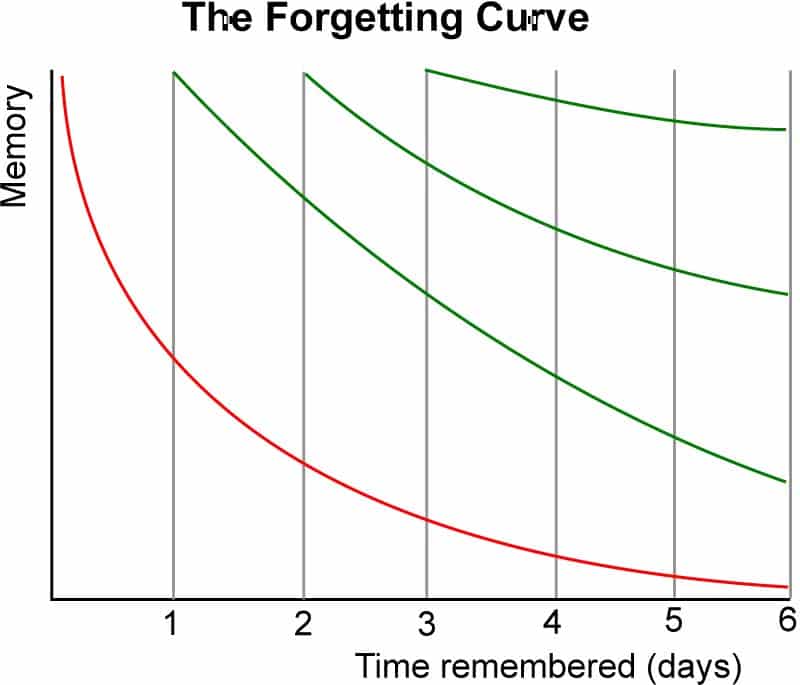
Compare the right-side green line with the left-side red line.
Someone who takes notes and reviews them three times (green line) remembers nearly everything after a week. On the other hand, a person who doesn’t review their notes at all (red line) forgets everything within a week.
Don’t be the red line – make sure you’re one of the green lines instead! To do so, you’ll need to learn how to take effective, visually interesting, and/or aesthetical notes.
To help you do so, these are the best note-taking methods:
Best Note-Taking Methods
Outline Note-Taking Method
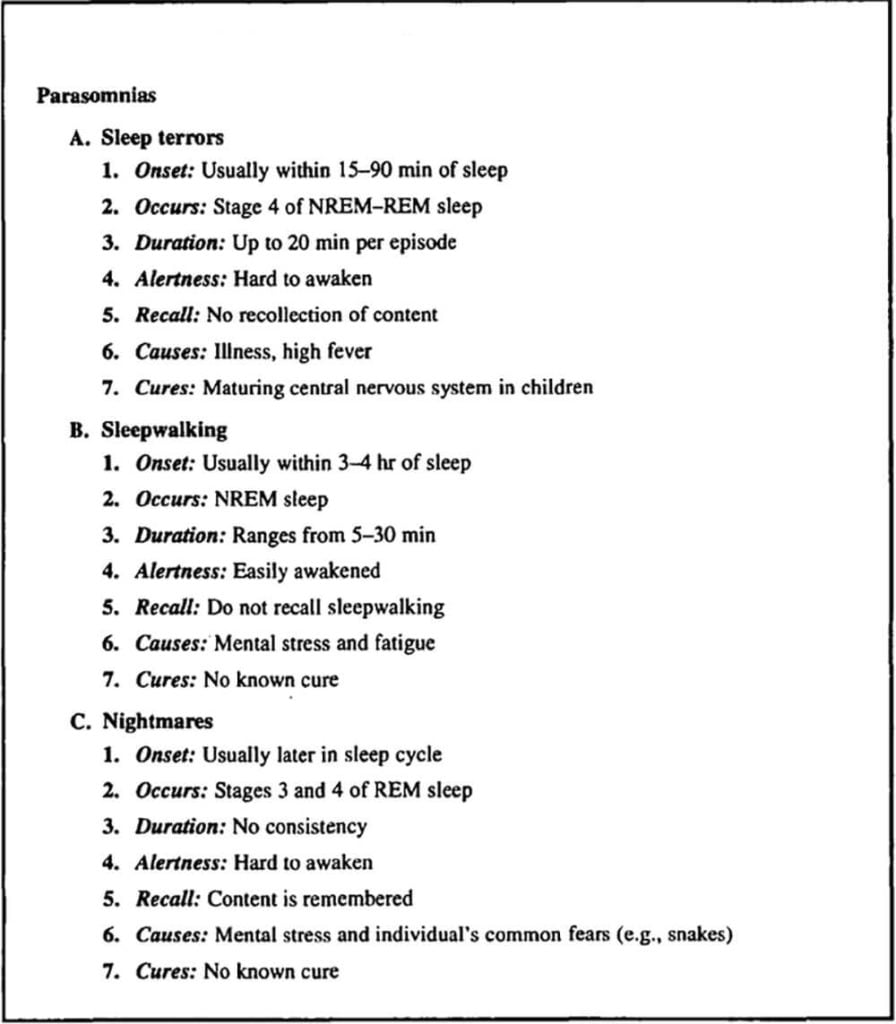
Best for: Most subjects except science classes such as physics or math
Difficulty level: Medium
The outline method of note-taking uses indentation to store information in a clear hierarchy. When applicable, the outline method is one of the most efficient note-taking formats as it creates meticulously well-organized notes. The method can also be used in both deductive and inductive order.
Outlined notes are some of the easiest to review, as it’s one of the few systems that allow you to see space relationships between topics. However, the method is not always suitable for taking notes during a live lecture, and outlining requires a clear lesson structure.
Advantages:
- Space relationships between topics are visible,
- Information is recorded in a logical, hierarchical manner,
- Outlined notes are quick and easy to review pre-exam,
- Special notepaper & preparation not required,
- Research on the outline method has been positive,
- Usable during class (slow to medium-paced lectures).
Disadvantages:
- Unsuitable for some STEM subjects,
- Learning materials/lectures require a clear structure,
- Outlining notes requires intense concentration and thought.
Cornell Note-Taking Method
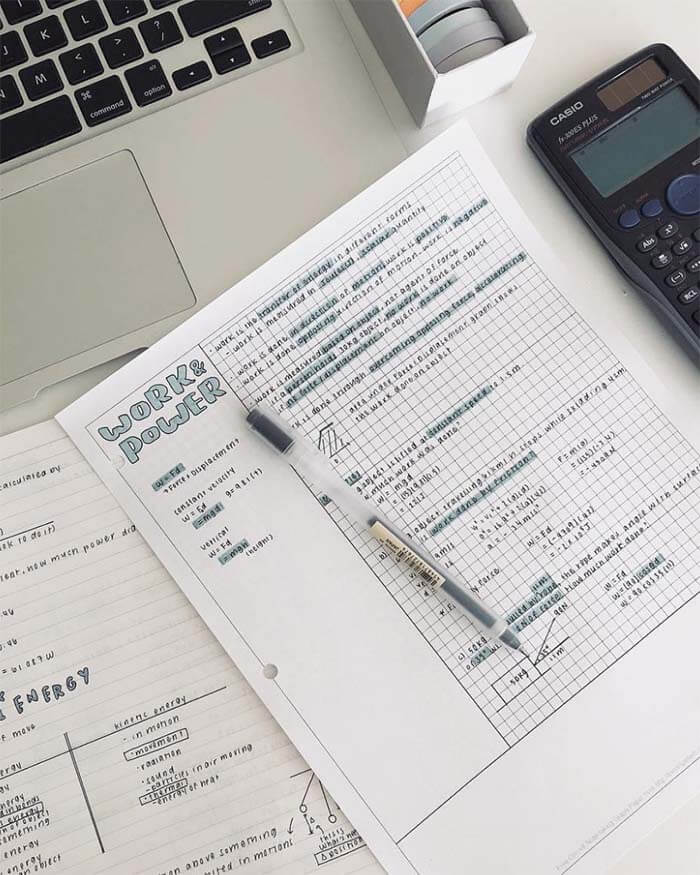
Best for: Recording main concepts & forming study questions
Difficulty level: Easy
The Cornell note-taking method, developed over half a century ago, is a tried-and-true strategy for taking effective notes. It uses two top columns (the “cue” and “note” columns), together with a single bottom row (the summary section), to record notes.
The method is versatile, usable for most subjects, and one of the simplest yet most effective note-taking methods. By mastering the Cornell system, you’ll always have at least one solid note-taking skill under your belt. The Cornell system is one of the most popular note-taking strategies in the world for a good reason.
Advantages:
- Organized and systematic for both recording and reviewing notes
- Time-efficient and requires little effort,
- Taking Cornell notes is very easy to learn,
- Suitable for most subjects (except equation-based subjects),
- Fulfills a natural learning cycle within one single page,
- Ideal for extracting major concepts and ideas.
Disadvantages:
- Requires creating or purchasing Cornell-style pages,
- Large quantities of Cornell notes can be challenging to organize,
- Not great at reducing the size of notes,
- Research on the Cornell method is mixed.
The Cornell method is a variant of the split-page note-taking method (also known as the two-column method). Try the split-page method if you are finding the Cornell method a bit too restrictive but you like the basic approach of cues or keywords combined with more detailed notes.
Boxing Note-Taking Method
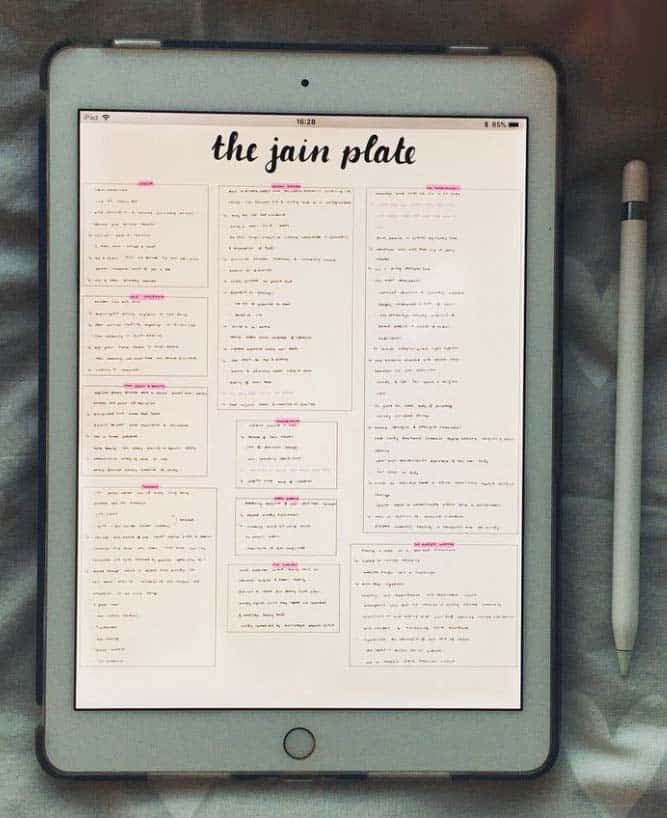
Best for: Digital note-taking with a stylus pen
Difficulty level: Easy
The boxing method of note-taking uses boxes to visually separate topics within a page. While the boxing method was designed for digital devices, it’s a technique that can be easily adapted to handwritten notes.
Using the boxing strategy results in notes that are visually pleasing and easy to review. The method also takes full advantage of digital-only features such as lassoing, resizing, and moving notes after writing. Together with mind mapping, it’s one of the most effective note-taking strategies for visual learners.
Advantages:
- Takes advantage of digital note-taking tools,
- Great for learners with a visual learning style,
- Aesthetically pleasing notes,
- Notes reduce well.
Disadvantages:
- Slightly time-intensive,
- Not always practical for note-taking during lectures.
Charting Note-Taking Method
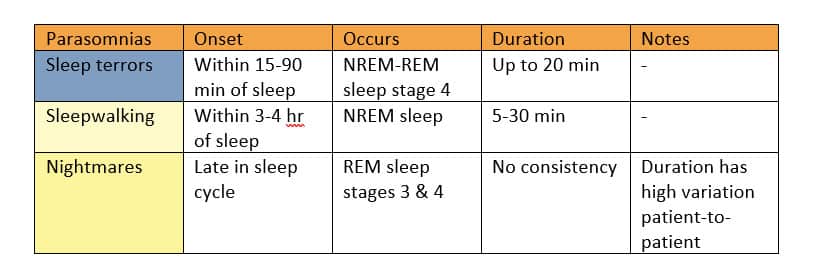
Best for: Recording facts and statistics
Difficulty level: Hard
The charting method of note-taking, also known as “matrix note-taking,” uses charts to classify information within rows and columns. While the method is not usable for many subjects, it is a remarkable tool under the right circumstances. This method is best used with subjects with factual or statistical information that can be categorized into tables.
On the other hand, it’s not suitable for note-taking during live lectures, very detailed topics, and subjects where the space relationships between content are essential. It’s also not well-suited for subjects that have many equation-based problems.
Advantages:
- A compelling method for subjects with lots of facts and statistics,
- Easy comparisons between different topics,
- Reduces note sizes better than any other method,
- Charted notes are straightforward and efficient to review,
- Very efficient for studying comparisons.
Disadvantages:
- Unsuitable for most subjects,
- Requires a basic understanding of the topic,
- Very time-intensive.
Mapping Note-Taking Method
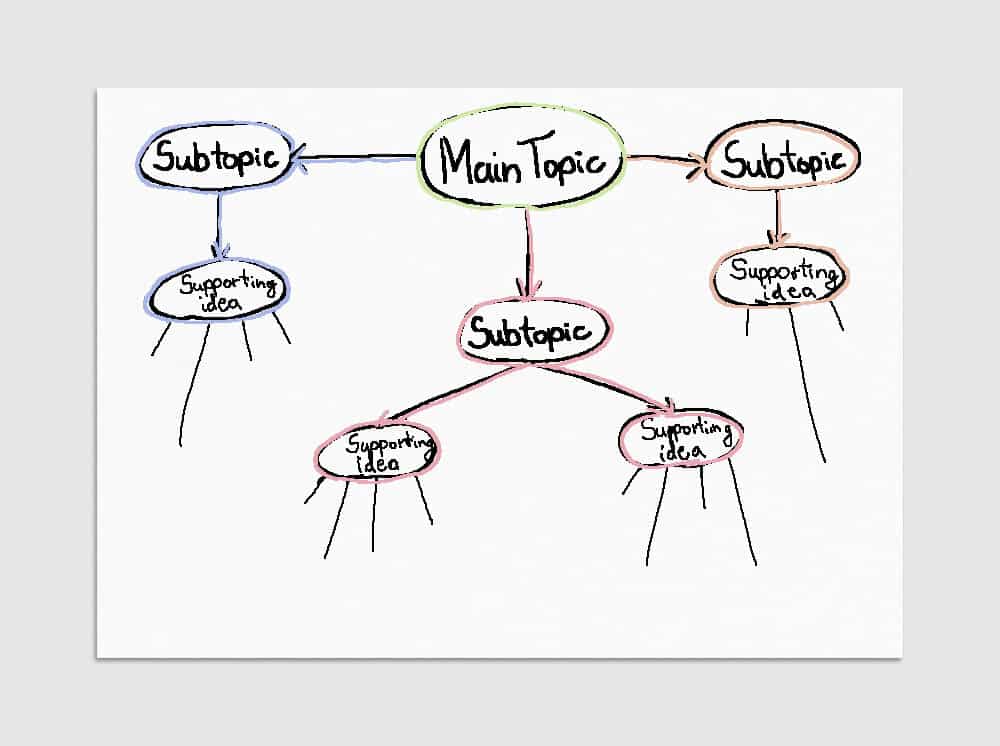
Best for: Analyzing visual connections between key ideas and concepts
Difficulty level: Hard
The mapping method of note-taking, also known as “concept mapping,” connects different thoughts, ideas, concepts, and facts through visualization. Both Leonardo Da Vinci’s and Albert Einstein’s notebooks reportedly contained mapping-style notes that connected drawings to words and notes.
The mapping method starts with a central topic in the middle of the page before branching into smaller subtopics, supporting topics, and more minor details. The method provides a one-of-a-kind graphical overview of lecture content that is irreplaceable for visual learners.
Mapping is best used in content-rich college classes where the information is structured. However, taking notes in a live class with this method is very rarely possible due to its time-consuming nature.
Advantages:
- An excellent method for visual learning styles,
- It gives a comprehensive overview of a large subject,
- It helps you understand the connections between small elements within a major topic,
- Maximizes active participation,
- Reviewing mapped notes is very efficient.
Disadvantages:
- Requires a good understanding of the topic,
- Requires strong concentration,
- It cannot be used effectively during class,
- It can be difficult to correctly include all relationships,
- Mapping is very time-consuming.
Sentence Note-Taking Method
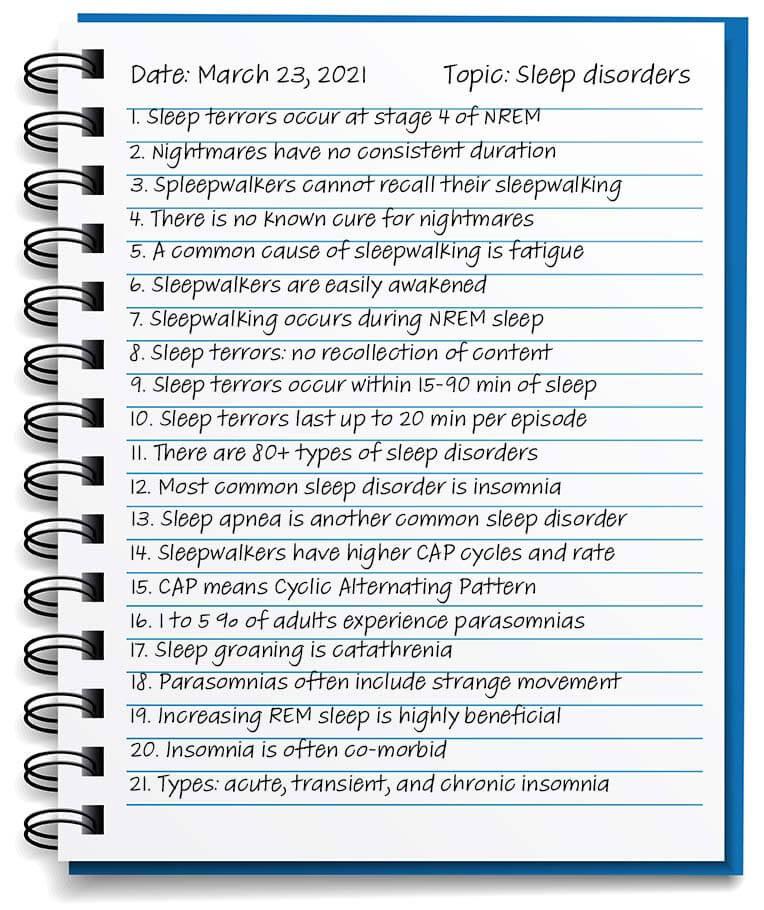
Best for: Quick, unstructured note-taking
Difficulty level: Very easy
The sentence method of note-taking uses sentences separated by lines to quickly transcribe as much information as possible from the information source. It requires quick handwriting or typing skills to be used effectively, and it’s likely the most commonly used note-taking method due to its simplicity.
Using the sentence method results in oversized notes that are notoriously difficult to review afterward. However, the sentence method can sometimes be the only viable choice for fast-paced, unstructured lessons you’re unprepared for. It’s often a good idea to rewrite notes taken with the sentence method after class.
Try not to rely on this method when you have a choice, but keep it as a backup plan when you can’t use an alternative note-taking strategy.
Advantages:
- It can be used for any subject and type of class,
- Very easy to implement,
- Suitable for quick note-taking during class.
Disadvantages:
- Reviewing sentence method notes after class is difficult and time-consuming,
- No inter- and intra- relationships between notes are visible,
- The main points are indistinguishable from more minor details,
- Quick handwriting or typing speed required,
- No element of metacognitive note analysis during note-taking.
Blurting Note-Taking Method
Best for: Studying and memorizing complex topics
Difficulty level: Medium
Unlike passively highlighting text or rereading notes, the Blurting Method is truly one of the most efficient ways to understand where you are at in your knowledge and do something about it at the same time.
The blurting method of note-taking is an active recall technique that can be used to help you learn and remember information. Active recall is basically a learning technique that involves testing yourself on the material that you’re trying to learn and has been shown to be a very effective way to make.
The blurting method, at its simplest, is reading a section of text or notes, then closing them and writing down as much of the information as you can remember. This makes your brain work harder to retain the information, making it really hammer the info down into your long-term memory.
Advantages:
- It can help you identify the areas where you need to focus in your study time, thus making sure that the gaps in your knowledge are covered.
- It gives you a better understanding of the material, as you are forced to put the information into your own words.
- Recall ensures information is retained longer.
- It’s a flexible method that can be modified to suit your needs.
- The method can be used on any type of written learning material – but also after listening to lectures and online course videos.
Disadvantages:
- This method is time-consuming, and some might find it tedious.
- It does not replace note-taking during on-going lectures.
- It is mentally taxing.
- It is not the most efficient method for memorizing a lot of facts – use flashcards or a similar method in this case
Q/E/C Note-Taking Method
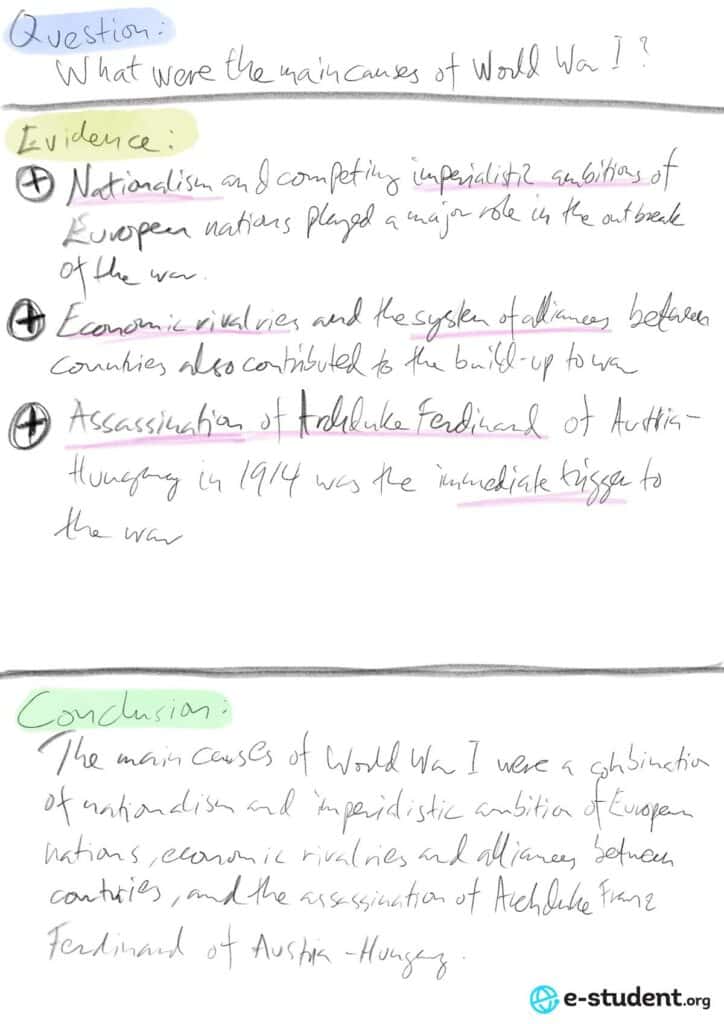
Best for: Argumentative subjects (such as history, philosophy, and literature)
Difficulty level: Medium
The Question/Evidence/Conclusion (Q/E/C) method of note-taking is a simple but powerful method for organizing and recording information from lectures. Focused on capturing the big ideas and how they relate to each other, the method is structured around concepts that require arguing and evidence to create a clear and concise summary. Each concept is divided up into three parts: question, evidence, and conclusion.
The Q/E/C is ideally suited for most subjects in the humanities, especially ones that tend to present in an argumentative form, such as history, philosophy, and literature. It is also a very useful method to include in your toolbox for other subjects, including technical ones, where it can be suited for certain classes.
The method is also an excellent way to outline or plan for your essays, as it helps you develop a clear structure and will likely help you identify additional questions and counterarguments along the way that you may need to consider.
Advantages:
- Helps you focus on the bigger picture
- Helps you keep track of the relationship between the overall topic and the arguments/evidence
- An excellent way to clearly record more argumentative presentations
- Clear way of presenting arguments and counterarguments
- Forces you to synthesize arguments and write a conclusion
- A good fit for the humanities and non-technical subjects
- Matches the way many lecturers present (and view the world)
- Useful method for outlining argumentative essays
Disadvantages:
- Less suitable for technical subjects or for concepts with more complex relationships
- Challenging to use during fast-paced or poorly structured lectures
- Requires concentration and reflection
- Can be difficult to use if you don’t yet have an overall grasp of a new subject
Morse Code Note-Taking Method

Best for: Quickly absorb large volumes of course material in argumentative subjects.
Difficulty level: Hard
A fairly recent addition to the realm of note-taking methods – but one that many academics swear by – is the Morse Code note-taking method, a variant of the Q/E/C method. Not to be confused with Morse Code itself, this note-taking method uses dots and dashes to mark up course literature while you are reading it. Importantly, it enables you to keep reading while taking notes rather than pausing to jot down your notes.
Dots are used to denote the main ideas, and dashes for supporting facts, arguments, and examples. After you have finished reading the entire text, you use your notes in the margin to type up notes and then condense them into a format that is useful for further review.
Advantages:
- As you do not stop reading, it is among the most efficient methods for covering larger quantities of text.
- It helps extract the main and supporting points from a text.
- It promotes active reading through the note-taking
- It facilitates reading comprehension and critical thinking through the decoding and condensing stages.
Disadvantages:
- It is not applicable to all types of reading material (in particular, material that is not structured in an argumentative academic style).
- Very little information is captured in your notes – if you wait too long to decode your notes, you may have forgotten the context.
- Less suitable for readers who tend to lose their focus when engaging in continuous reading (who may benefit from pausing and processing their notes paragraph by paragraph or page by page.
Flow Note-Taking Method
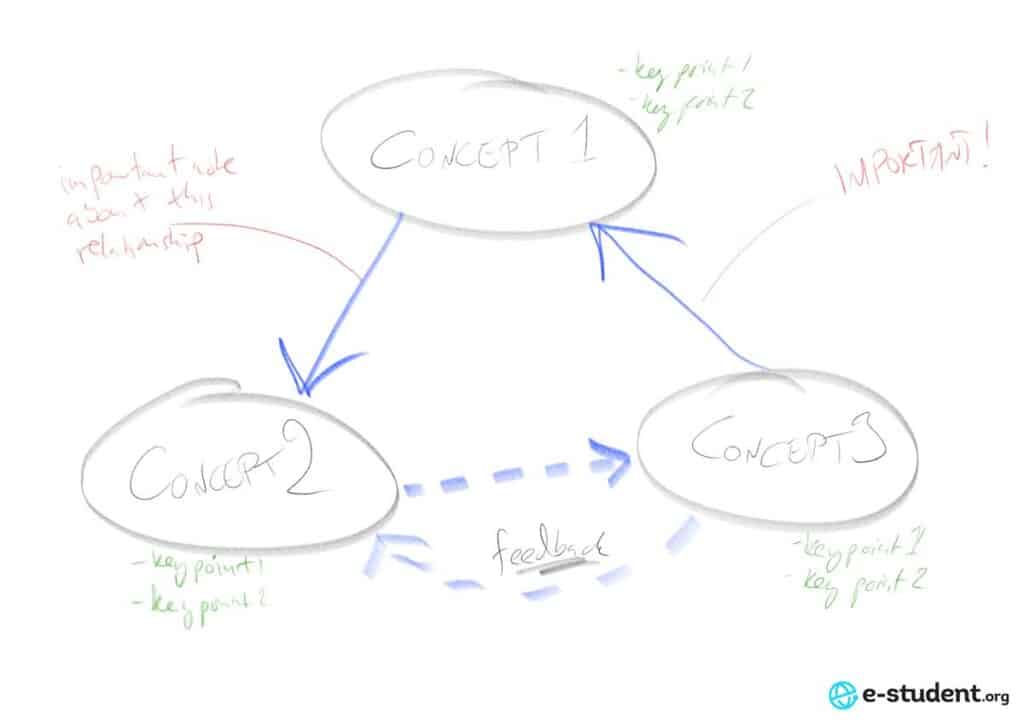
Best for: Understanding interrelationships between concepts at a higher level
Difficulty level: Hard
While linear note-taking methods (such as the sentence and outline methods) have their place in your toolkit, you will want to complement these with non-linear methods that force you to actively engage with the topic at hand as a whole. Using such methods translate into a better understanding of an area and how its different component parts relate to each other. One of the main non-linear approaches that you should become familiar with is the flow method of note-taking.
It can look similar to the mapping method, but the focus of this method is on the higher-level concepts and ideas and how they relate to each other. Detailed descriptions and paraphernalia have to take a step back. The relationships are indicated using arrows and lines, in whichever way you find useful.
Advantages:
- The flow method aims to have you learn during class by having you engage actively with the content.
- Even though you are actively learning during class, you also get useful notes for revision – while the notes are not in the most useful format for revision, they tend not to be terrible
- It’s a flexible method that suits most subjects.
- It is a good choice for note-taking after having followed a class or after having read all material to solidify your understanding.
- The method can be personalized to suit individuals’ needs and preferences.
Disadvantages:
- The flow method is not well suited for topics of which you have no prior understanding, as it can be difficult to pick out what is more or less important and figure out how they relate to each other during the class.
- While engaging mainly with the bigger picture, you risk missing important details during lectures.
- Flow notes can easily turn out quite messy and are not ideal for revision (you can try to mitigate this by adding cue words to your notes to prompt you to describe relationships during revisions).
- It can be difficult to find the time to actively engage with a topic during fast-paced lectures, forcing you to take detailed notes and apply the flow method after class instead.
- Practice with the method is needed as you need to figure out how to best use it to suit your learning style.
REAP Method
Best for: Active reading to build deeper understanding of texts
Difficulty level: Hard
The REAP method (Read, Encode, Annotate, Ponder) was developed by Marilyn Eanet and Anthony Manzo at the University of Missouri at Kansas City in 1976 as a response to what they saw as inadequate teaching methods for developing active reading. The method is designed to help students be able to understand the meaning of texts through reflecting and communicating on their content.
REAP consists of four stages:
- Reading: Reading the text provided to identify the ideas expressed by the author.
- Encoding: “Encoding” the main ideas identified in the text in your own words.
- Annotating: Writing “annotations” of the ideas, quotes, etc., in the text.
- Pondering: Reflecting on the content and writing comments or criticisms of the text, and discussing with others.
This will make you return to a text multiple times, each time from a different vantage point, and let you gradually analyze the text at a higher and higher level.
Advantages:
- A scientifically proven effective method for improving reading comprehension and recall
- Helps build capacity to engage critically with texts
- Provides a framework for re-engaging with a text from multiple vantage points
Disadvantages:
- Method that takes a lot of time, focus, and mental energy
- Not suitable for note-taking during lectures
- Less suitable for all texts (such as some college textbooks) or learning purposes (such as more detailed memorization)
Focused Question Clusters Method
Best for: Preparing for multiple-choice or other fact-based tests
Difficulty level: Hard
Focused Question Clusters is a method, proposed by Cal Newport, to help students use their textbooks and existing lecture notes to prepare for MCQ-style exams by writing questions and then quizzing themselves.
Focused Question Clusters involve the following main steps:
- Identify your main topic and the relevant subtopics.
- For each subtopic, write a series (or a “cluster”) of questions that relate to it, covering the main points. The questions should be clear and possible to answer with a few words.
- Write a few background topics to the topic as a whole.
- Use these questions to review (you might want to employ one of the relevant study methods for how you quiz yourself, such as active recall)
Although this kind of rapid-fire questions will help most with preparing for multiple-choice style exams, the engagement with the material will also help your brain to make the connections to get a deeper understanding of the topic.
Advantages:
- An effective way to gain and retain knowledge about a topic
- Particularly effective for MCQ-style exams
- A useful tool for studying in groups
- Question drafting can be divided up and the results shared as a resource between students studying together
Disadvantages:
- Drafting the questions takes a considerable amount of time and effort
- Not the best way to engage with more argumentative topics
Highlighting Method
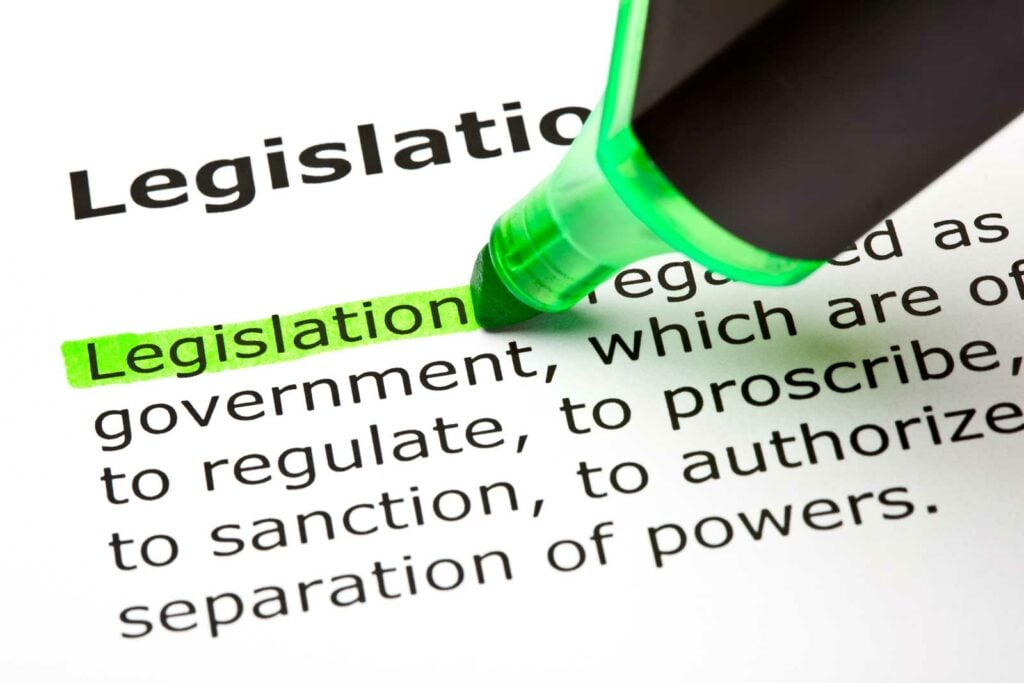
Best for: Quickly marking up a text that you plan to review later on.
Difficulty level: Easy
Highlighting is a popular study technique that involves marking important passages in a text. The overall idea is to highlight important points in a text – common ones are key numbers, dates, names, and other key points – that can then be easily spotted when reviewing the whole material. In its pure form, it does not involve writing any notes, but in practice, it is often combined with other note-taking methods.
This a useful method for students, researchers, and anyone else who needs to go through a lot of material as it allows them to quickly find the information they need later on. Note, however, that while this method is very commonly used, it has been the topic of scientific studies that have found it of questionable value for studying.
Advantages:
- Easy to get started with.
- Does not require writing.
- Provides you with a marked-up text that can help you revise more efficiently.
Disadvantages:
- It’s easy to go on autopilot with the method and become a passive reader rather than actively engaging with the text.
- Studies have found it to be of questionable value.


